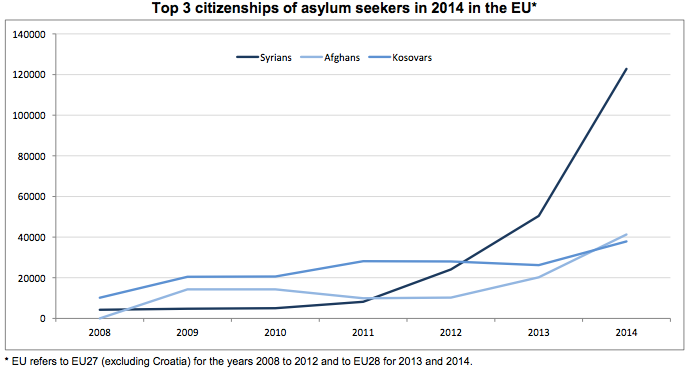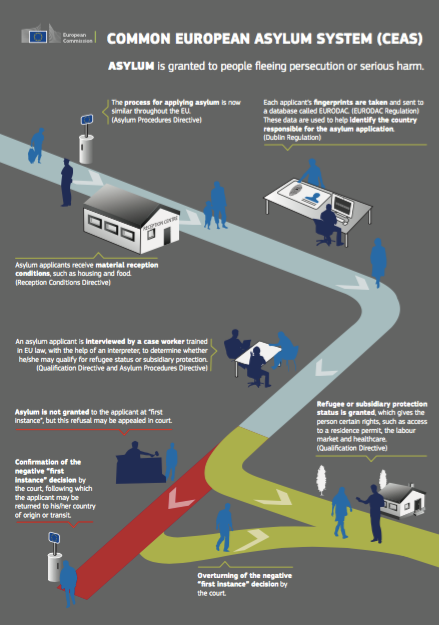The European Union is expected to receive its highest-ever annual number of asylum applications by the end of this year, after a record-breaking 626,000 applications were reviewed in 2014. Europe has seen a rise in migrants and refugees arriving on its borders, many of whom will seek asylum in different countries of the EU. The surge has raised questions about the responsibilities of each European state under asylum laws and the sustainability of the current system.
What is asylum?
Asylum has been a core tenet of international law since the passage of the 1951 Geneva Convention on the Protection of Refugees. According to the convention, people are granted asylum if they seek protection from a well-founded fear of persecution due to race, religion, nationality, membership in a particular social group or political opinion. Asylum-seekers whose applications are recognized are entitled to remain in the country and receive its protection.
According to the European Commission's Migration and Home Affairs office, "EU Member States have a shared responsibility to welcome asylum seekers in a dignified manner, ensuring they are treated fairly and that their case is examined to uniform standards so that, no matter where an applicant applies, the outcome will be similar."
Where are Europe's asylum-seekers coming from?
According to Eurostat, the EU's statistical office, Syrians represented the largest proportion of asylum-seekers in 2014. Afghans came in second, totaling 41,300 applicants in 2014, and Kosovars were the third-largest group at 37,900 applications.

Asylum-seekers in 2014 primarily came from Syria, Afghanistan, and Kosovo. The proportion of Syrians seeking asylum skyrocketed in 2012 after the country descended into civil war.
How does one apply for asylum in the EU?
The EU instituted the Common European Asylum System in 1999 to ensure the protection of international asylum law in EU member states.
1. Asylum-seekers arrive in an EU country, where official in an immigration center takes their fingerprints and stores them in the EURODAC database. The Dublin Regulation stipulates that asylum claims must be processed in the first country that the asylum-seeker reaches. Last week, Germany announced it had annulled the Dublin requirement for Syrian refugees, meaning that regardless of where Syrians first enter the EU, they are eligible to apply for asylum in Germany.
2. Once fingerprints are processed, officials can determine which member state will ultimately examine the asylum application. The decision rests upon multiple factors, including whether the asylum-seeker has family members in an EU member state, whether the person has a visa or residence permit and whether the person has entered the EU legally or illegally.
3. EU countries are obligated to provide asylum-seekers with "harmonised standards of reception" while they wait for a decision on their application. This includes limited detention and free legal assistance. Asylum-seekers must also be granted access to employment within nine months.
4. The asylum-seeker then gets assigned a case worker who will help determine whether they qualify for refugee status or subsidiary protection. Under the Qualification Directive, asylum-seekers are granted rights to employment, health care, education, social welfare and so forth throughout the application process, which is supposed to take no longer than six months.
5. If the application is declined, the asylum-seeker may file an appeal with a judge or be sent back to his or her country of origin. If the appeal is granted, the process continues.
While the application for asylum is uniform across the EU, the number of applications accepted is at the discretion of each member state. This explains why the majority of asylum-seekers head to countries like Germany and Sweden, which have the highest acceptance rates. Of the 122,800 Syrians who applied for asylum last year, about 60 percent were registered in Germany and Sweden alone.

Why has the process been called into question recently?
The exponential increase in refugees and asylum-seekers across the EU has placed tremendous strain on Europe's common asylum system. Germany alone is expecting 800,000 people to reach its borders by the end of 2015. Greece began bringing refugees to its mainland after some shelters on Greek islands found themselves completely overwhelmed: More than 2,000 people docked in the port city of Piraeus in a single night. On Tuesday, Hungarian officials were forced to shut down Budapest's Keleti train station after thousands of people began passing through the terminal to board trains into western Europe.
Inadequate resources have created enormous difficulties for those countries where refugees first arrive as well as those accepting asylum-seekers, both within the EU and elsewhere.
Germany has called on EU leadership to come together and form a comprehensive plan so that the countries receiving migrants -- Germany, Greece and Italy, to name a few -- have adequate resources at their disposal.
"The German government says the Dublin approach is not working anymore, because so many refugees are arriving at our external borders, that we can't leave Italy or Greece alone to deal with this task," Chancellor Angela Merkel said Thursday in Berne. "At the same time, if we say that Italy and Greece can't be left alone with this task, then neither can it be that three countries, like Sweden, Austria and Germany, are left alone with the lion's share of the task."
EU leaders will meet in Brussels on Sept. 14 to discuss potential solutions.
